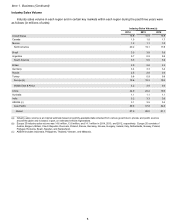Ford 2014 Annual Report Download - page 21
Download and view the complete annual report
Please find page 21 of the 2014 Ford annual report below. You can navigate through the pages in the report by either clicking on the pages listed below, or by using the keyword search tool below to find specific information within the annual report.Item 1A. Risk Factors (Continued)
Fluctuations in foreign currency exchange rates, commodity prices, and interest rates. As a resource-
intensive manufacturing operation, we are exposed to a variety of market and asset risks, including the effects of
changes in foreign currency exchange rates, commodity prices, and interest rates. These risks affect our Automotive
and Financial Services sectors. We monitor and manage these exposures as an integral part of our overall risk
management program, which recognizes the unpredictability of markets and seeks to reduce potentially adverse
effects on our business. Nevertheless, changes in currency exchange rates, commodity prices, and interest rates
cannot always be predicted or hedged. In addition, because of intense price competition and our high level of fixed
costs, we may not be able to address such changes even if foreseeable. As a result, substantial unfavorable changes
in foreign currency exchange rates, commodity prices, or interest rates could have a substantial adverse effect on our
financial condition and results of operations. See “Overview” to Item 7 and Item 7A for additional discussion of
currency, commodity price, and interest rate risks.
Adverse effects resulting from economic, geopolitical, or other events. With the increasing
interconnectedness of global economic and financial systems, a financial crisis, natural disaster, geopolitical crisis, or
other significant event in one area of the world can have an immediate and devastating impact on markets around the
world. For example, the financial crisis that began in the United States in 2008 quickly spread to other markets; natural
disasters in Japan and Thailand during 2011 caused production interruptions and delays not just in Asia Pacific but
other regions around the world; and episodes of increased geopolitical tensions or acts of terrorism have at times
caused adverse reactions that may spread to economies around the globe.
Concerns persist regarding the debt burden of certain countries that have adopted the euro currency (“euro area
countries”) and the ability of these countries to meet future financial obligations, as well as concerns regarding the
overall stability of the euro and the suitability of the euro as a single currency given the diverse economic and political
circumstances of individual euro area countries. If a country within the euro area were to default on its debt or
withdraw from the euro currency, or—in a more extreme circumstance—the euro currency were to be dissolved
entirely, the impact on markets around the world, and on Ford’s global business, could be immediate and significant.
Such a scenario—or the perception that such a development is imminent—could adversely affect the value of our
euro-denominated assets and obligations. In addition, such a development could cause financial and capital markets
within and outside Europe to constrict, thereby negatively impacting our ability to finance our business, and also could
cause a substantial dip in consumer confidence and spending that could negatively impact sales of vehicles. Any one
of these impacts could have a substantial adverse effect on our financial condition and results of operations.
In addition, we have operations in various markets with volatile economic or political environments and are pursuing
growth opportunities in a number of newly developed and emerging markets. These investments may expose us to
heightened risks of economic, geopolitical, or other events, including governmental takeover (i.e., nationalization) of
our manufacturing facilities or intellectual property, restrictive exchange or import controls, disruption of operations as a
result of systemic political or economic instability, outbreak of war or expansion of hostilities, and acts of terrorism,
each of which could have a substantial adverse effect on our financial condition and results of operations. Further, the
U.S. government and other governments could impose additional sanctions that could restrict us from doing business
directly or indirectly in or with certain countries or parties, which could include affiliates.
Economic distress of suppliers that may require Ford to provide substantial financial support or take other
measures to ensure supplies of components or materials and could increase costs, affect liquidity, or cause
production constraints or disruptions. The automotive industry supply base experienced increased economic
distress due to the sudden and substantial drop in industry sales volumes beginning in 2008. Dramatically lower
industry sales volume made existing debt obligations and fixed cost levels difficult for many suppliers to manage,
increasing pressure on the supply base. As a result, suppliers not only were less willing to reduce prices, but some
requested direct or indirect price increases as well as new and shorter payment terms. At times, we have had to
provide financial assistance to key suppliers to ensure an uninterrupted supply of materials and components. In
addition, where suppliers have exited certain lines of business or closed facilities due to the economic downturn or
other reasons, we generally experience additional costs associated with transitioning to new suppliers. Each of these
factors could have a substantial adverse effect on our financial condition and results of operations.
15
























